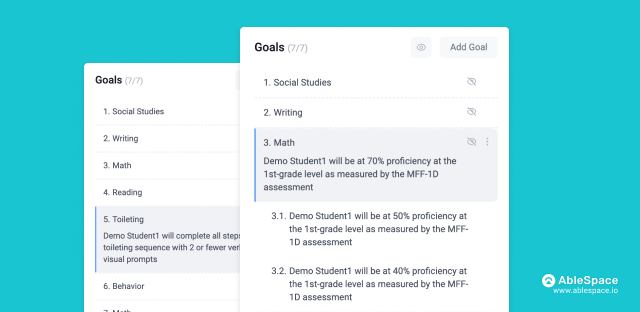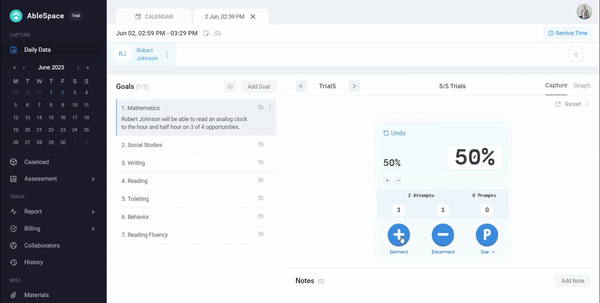
Progress Monitoring for Individualized Education Program (IEP) Goals is a critical process in special education that tracks and evaluates the progress of students with disabilities toward their customized educational goals. It involves collecting and analyzing data on specific skills and behaviors outlined in the student's IEP.
Progress monitoring helps determine if instructional strategies and interventions are effective, identifies areas that need additional support or modifications, and facilitates collaboration among the IEP team. It aims to ensure students with disabilities make meaningful progress and achieve their educational objectives.
This commitment to student progress aligns with the provisions of the Individuals with Disabilities Education Act (IDEA). This federal law ensures that students with disabilities in the United States receive a free and appropriate public education. It also provides personalized education plans, accommodations, and related services based on individual needs.
For example, a student with autism named Emma receives an Individualized Education Program (IEP) that includes specific goals, accommodations, and therapy services to support her academic and social development. In addition, IDEA promotes parental involvement and progress monitoring to ensure students with disabilities have equal access to education and the opportunity to reach their full potential.
Let’s go through the following steps that outline how to monitor a student’s progress-
1. Measurable IEP Goals-
Measurable IEP goals are specific, attainable objectives in a legally binding document for students with special education needs. They provide clear criteria to assess progress and allow growth tracking over time. These goals are essential for determining meaningful progress and adjusting instruction or interventions.
For instance, a measurable goal could be "By the end of the school year, Sophia will increase her reading fluency from 50 to 80 words per minute as measured by weekly timed reading assessments." This goal is specific, indicating the targeted area (reading fluency), the desired improvement (from 50 to 80 words per minute), the timeframe (by the end of the school year), and the measurement tool (weekly timed reading assessments). It provides a clear benchmark for evaluating Sophia’s progress.
On the other hand, a non-measurable goal might be "James will do his best in math class." While this goal expresses good intentions, it needs more specificity and objectivity. It needs to provide a clear standard or measurement criteria to assess James's progress.
2. Collect Baseline Data -
Collecting baseline data in special education involves gathering information about a student's current skills, abilities, and performance levels related to specific goals or objectives outlined in their Individualized Education Program (IEP).
For example, a special educator may administer a reading assessment to determine a student's baseline performance in reading fluency. The assessment involves measuring the number of words read correctly per minute. The baseline data could show that the student reads 60 words per minute.
With this baseline data, the educator can set measurable student progress goals. For instance, the goal might be to increase the student's reading fluency to 100 words per minute by the end of the school year. By regularly monitoring the student's progress and comparing it to the baseline data, the educator can assess whether the student is making meaningful progress toward the goal.
3. Collect Data on IEP Goals-
Educators, special education teachers, and related service providers like paraprofessionals and therapists who directly engage with students in special education take charge of collecting data for progress monitoring purposes.
To ensure effective progress monitoring, educators should regularly collect data on each IEP goal, following a predetermined schedule. As mandated by IDEA regulations, this schedule should be documented by the IEP team, specifying the frequency of monitoring (e.g. every two weeks, monthly).
For example, a student named Alex with an IEP goal focused on improving their reading comprehension skills. The IEP team determines that progress monitoring for this goal will occur every two weeks. Following the established schedule, the educator administers a reading comprehension assessment to Alex every two weeks to gather data on their progress.
During each assessment, the educator may use reading passages or comprehension questions to evaluate Alex's understanding and retention of the text. Then, they carefully record and analyze the results, noting the specific area of improvement and any challenges Alex faces.
When faced with challenges in collecting data on Individualized Education Program (IEP) goals, adopting a digital platform like AbleSpace can address challenges in collecting data on IEP goals.
It offers streamlined data collection, increased efficiency, and improved accuracy, benefiting educators and professionals by supporting progress monitoring and enhancing the reliability of the data.
4. Create a Graph-

Creating a graph of progress monitoring IEP goals is a valuable tool in special education to represent a student's progress over time visually. Educators can track and measure students' growth by graphing data points, identifying trends, and making data-informed decisions to support their educational needs.
Example: a student named Jack with an IEP Goal related to reading fluency. The goal states, "Jack will read 80 words per minute with 90% accuracy by the end of the school year."
The educator collects data on Jack's reading fluency throughout the year using weekly assessments. The data is recorded and plotted on a graph with time on the x-axis and words per minute on the y-axis. As the week progresses, the graph's data points represent Jack's reading fluency scores.
By analyzing the graph, the educator can observe the trend of Jack's progress. They can identify if Jack is consistently improving, plateauing, or facing challenges in reaching the goal. This information can guide instructional decisions, interventions, and support to help Jack achieve the desired reading fluency level.
If you need help creating a graph for progress monitoring of Individualized Education Program (IEP) goals, utilizing a digital platform like AbleSpace can be invaluable. AbleSpace provides a user-friendly interface and tools specifically designed to assist in creating visually appealing and informative graphs.
5. Review Data
Reviewing data is crucial in special education to assess students' progress toward their individualized education program (IEP) goals. By regularly reviewing and analyzing the collected data, educators can gain valuable insights into a student's growth, identify areas of strength and improvement, and make informed decisions to support their educational needs effectively.
Example: a student named Emily with an IEP goal related to writing skills. The goal states, "Emily will independently write a coherent paragraph with proper grammar and punctuation."
The educator collects data on Emily's writing skills by reviewing her written assignments throughout the school year. First, they assess each paragraph's coherence, grammar, and punctuation and record the data. Then, they compare the data points to the baseline data and previous assessments to track Emily's progress.
During the data review, the educator notices that Emily's writing skills have improved in coherence and grammar, but there are still areas for punctuation improvement. Based on this analysis, the educator can plan targeted interventions and provide specific feedback to Emily to address the punctuation challenges.
If you encounter challenges when reviewing data related to the progress monitoring of Individualized Education Program (IEP) goals, AbleSpace, enables educators and professionals to access and review data conveniently.
6. Progress Report-
The process of creating a progress report entails the following steps-
- Begin by reviewing the student's individualized education program (IEP) goals to gain a clear understanding of the specific objectives.
- Gather student progress data using assessments, observations, and work samples.
- Analyze the data to identify patterns, strengths, and improvement areas.
- Assess the student's progress about each goal, comparing it to baseline data or previous reports.
- Finally, provide detailed feedback and evaluate the level of achievement for each goal.
Determining the Frequency of Monitoring IEP Progress-
Monitoring IEP progress should occur regularly and continuously throughout the academic year.
The frequency of monitoring may vary depending on factors such as the student's needs and goals. However, it is important to adhere to the timeline specified in the IEP and maintain open communication with parents and the IEP team.
Regular monitoring allows for tracking progress and identifying areas needing adjustment or intervention and ensures that the educational program remains responsive to the student's needs.
Engaging Parents in Progress Updates
Communicating progress to parents is vital to progress monitoring in special education. Regular and effective communication ensures that parents are well-informed about their child's development, achievements, and areas needing improvement.
By effectively communicating progress to parents, special education professionals can build trust, strengthen partnerships, and work together to provide the best possible support for the student's educational journey.
Members of the IEP Progress Monitoring Team-
1. Special Education Teacher
2. Parents/Guardians
3. School Administrators
4. School Psychologist
5. Speech-Language Pathologist
6. General Education Teacher
7. Occupational Therapist
8. Other specialists
Effortless IEP Goal Tracking and Progress Monitoring-
If you're looking for a convenient solution to track IEP Goals and monitor the progress that allows IEP teams to reprint goals easily and provide space for teachers and service providers to document data, the IEP goal-tracking website AbleSpace is designed to simplify progress monitoring and ensure clear and accessible data tracking for your convenience.




